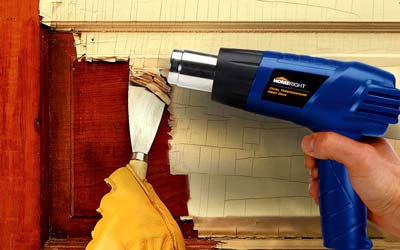
You might be surprised by how common it is to spill paint over wood, and it happens to all of us. Fortunately, most paint stains can be easily removed.
Removing acrylic paint from your wood is easier than you think. Some people might be concerned about taking the paint off and damaging it.
You probably don’t want to mess up the wood either. Whatever the reason might be, we got you covered.
By the time you’re done reading this article, getting acrylic off wood will be a piece of cake. Next, you’ll find some of the most effective and most accessible methods to follow along:
How to Get Acrylic Paint off Wood : Top 6 Method Explained

Stripping paint from your wood is surprisingly easy, and the things that we will need are things that most people have at home.
Here are a few methods you can proceed to get rid of the acrylic paint on your wood. Be it a table, a door, a piece of furniture, etc.
1. Soap and Rag
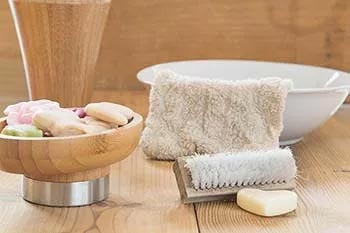
This is the simplest method of all. You don’t need to waste any time or effort, and it is decently effective. Here’s what you need to make it happen:
Things You Will Need
•Soap
•A rag
•Gloves
As you see, it’s pretty straightforward. So, you can gather them without making much of an effort, wasting money, or even getting out of your house. Then proceed following the next steps:
Wipe Off the Acrylic
Once you’re ready to start, dampen a rag and wipe the acrylic paint with it.
1. Dampen a rag and apply medium pressure as you rub it back and forth.
2. Rotate your rag around to prevent it from getting saturated.
3. Keep in mind that this might not work on paint stains that have been around for a while.
The whole purpose is to get rid of the extra acrylic that’s still fresh.
Clean the Surface
After rubbing the wet rag over the wood, you can proceed to clean it deeply. Here’s how:
1. Pour hot water into a rag and use some soap.
2. Use any glycerin soap, it doesn’t matter what type of soap you use. As long as it produces enough lather, you should be fine.
This solution should help you clean the surface deep enough, so not a single pinch of acrylic paint stays behind.
Rub Gently
Do not go hard on the surface. Be as careful as you can using a rough rag. If needed, apply medium pressure.
1. Be gentle when rubbing your rag on the remaining paint.
2. Keep rubbing your rag across the surface. Add more soap if needed until the stain is completely gone.
3. Depending on the extent of the paint, you may need several rags.
It’s essential to be extra careful, so don’t overlook this step.
Keep Wiping
You need to wipe the whole surface for a few minutes up to a few hours. This is the only way to get rid of the entire acrylic from the wood. Follow these steps:
1. Damp your rag to get any soap residue off of the wood.
2. Keep wiping until you have neutralized the soap.
Be consistent with getting rid of every trace of acrylic.
Let Your Wood Dry
Once you’ve removed the acrylic, the wood will be all wet. You’ll have to let it dry.
1. Use a dry rag to remove moisture from damp area. Rub the rag against the damp surface until there is no water left.
2. The wood might still be damp, so let it dry for 48 hours.
3. Depending on how big your wood is, this process could take more or less time.
Once the wood dries up completely, then you’ve successfully removed acrylic from it using a rag and soap.
2. Olive Oil

If the first method doesn’t do the trick for you, don’t worry. We got more techniques that could help you remove that annoying paint from your wood. This is a great alternative, and it’s also a natural product. So, let’s go ahead and give it a try.
Things You Will Need
It’s all about scraping, so you’ll need –
•Paint scraper
•Putty knife (optional)
•Rag
•Olive oil
These items are easy to find at home, so you should not have any problem gathering them.
Soften the Paint
Using olive oil, you will have to soften up the paint. This shouldn’t be much of a problem; you just need to follow these steps:
1. Pour some olive oil on the rag. Then rub the rag with the oil around the wood surface.
2. Spread the oil in every place you find acrylic paint.
This should start softening up the surface.
Let It Sit
You will have to let the olive oil sit on the acrylic paint for at least 15 minutes. This should get deep into the paint and get it off the wood.
1. Do not touch the surface while the oil does the job.
2. If you can let it sit for 30 minutes or more than that, it would be even better.
You will see how the acrylic paint starts softening up.
Scrape the Paint
Once the paint has completely softened, you can scrape it off. Here, use the paint scraper or putty knife as per your preference.
1. Start softly pushing the knife and scraping the surface off the paint.
2. Try not to damage the wood. Remove all the acrylic paint you can.
After 30 minutes to 1 hour, you should have completely removed the paint using olive oil as a softener. Use any tool you feel comfortable with.
3. Removing Acrylic Paint from Wood Using Alcohol
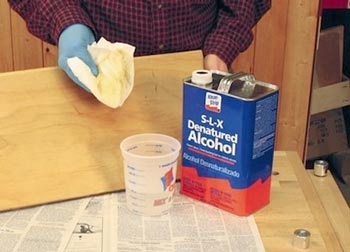
Alcohol is another excellent product you can use to get rid of acrylic paint. Here, we’ll explain how it works:
Things You’ll Need
•Alcohol
•Putty knife
•Old rag
•Fresh rag
Pour Alcohol on a Rag
Here, you need to pour alcohol on the rag so you can start wiping the surface with the paint.
1. Get any basic rubbing alcohol. If needed, go to a drugstore and get one.
2. Grab a rag and cover the bottle. Now shake it as hard as you can until you notice the rag is slightly damped.
This will give you the green light to start scraping it off.
Scrape the Paint
Here, you will have to remove the acrylic paint with a putty knife:
1. Try to chip off the top layer as much as possible. Be careful when doing so as you might damage the wood and leave some marks.
The more layers you remove, the easier it will be for the alcohol to cut through.
Rub the Paint Off
This is the most crucial step, so proceed with care but also effectively. Here’s how:
1. Start by rubbing it back and forth on the surface until the paint is separated from the wood.
2. Keep adding as much alcohol as needed to the cloth. Don’t moist the whole piece, but make sure it is sufficiently moist.
3. Please be careful when using alcohol as it could damage your wood. Don’t be too harsh when rubbing the paint off.
Remember, this is to soften up the paint so you can later get rid of the excess.
Wipe the Alcohol Away
Remove any extra sign of acrylic paint left. This should be pretty easy.
1. Get a clean and fresh rag and pour some water on it.
2. Rub the rag back and forth on the damp surface until there is no moisture.
3. This might take up to 24 hours until the wood is completely dry.
4. Wipe the area to remove the alcohol residue.
Leave the wooden surface as pristine as possible. Now, you’ve successfully removed the acrylic paint.
4. Heat Gun
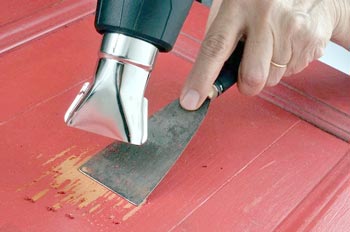
Well, the heat gun is also effective at removing acrylic paint even if it doesn’t look like so. Here we’ll tell you how that’s possible:
Items You’ll Need
•Heat gun
•A putty knife
•A rag or piece of cloth
•Sandpaper (optional)
Find Out Whether the Painted Area Is Large Enough
It’s up to you whether you want to remove pain stain from your door or any other type of wood. Either way, it’s worth a try.
•If you’re actually going to get a heat gun, they are cheap easy to find at most craft stores.
Be Careful
Keep in mind that a heat gun is not the same as a blow dryer, it has a little more horsepower, so you have to be careful with it.
We highly recommend reading the instructions before you start stripping your paint using the heat gun. We also recommend wearing protective gear such as safety glasses as well as a mask.
Now bear in mind that a heat gun is like ironing, you want it to be versatile and not hold it for too long in a single place because the heat will loosen up the paint and it could scrape it all off.
It may not be fast, but this a very efficient way to strip paint as long as you are careful when doing so.
Heat Up the Paint
Apply some heat on the wood surface and make sure to cover the entire area where the acrylic paint is.
1. Hold the tool with one hand, keeping the ventilation slots uncovered.
2. Before attempting to strip the paint, warm up the gun, give a few minutes before using it.
3. You might want to test the temperature first on the part of the wood where it won’t be noticed.
4. Hold it 4 inches from the stain to prevent damage to the wood for 10 to 20 seconds.
5. Don’t hold it in one place for long as it could damage your wood.
After heating up the whole surface, you’re almost ready to start getting the paint off.
Scrape It Off
While the acrylic paint starts to heat up, you can begin to scrape it. Proceed this way:
1. With one hand, grab the heat gun and then try to get underneath the paint stain using the blade of your knife.
2. Position the nozzle just ahead of the putty knife.
3. Don’t try to remove vast swathes of paint at once, go for the easy strips first.
4. At this point, the paint stain should start to come off.
5. Don’t let too much gunk build up on your putty knife.
6. Turn the heat gun off every time you need to clean your putty knife.
7. Keep in mind that paint stain doesn’t always come off as easy, so be patient and take as much time as needed.
8. Switch off the gun and let it cool down for at least 30 minutes before storing it.
At this moment, you should have the whole surface free of any acrylic paint. It’s time to clean the residues.
Wipe the Surface
Once you’re at this part of this process, there are a couple of different ways that you can get the residue off:
1. Let the wood cool off isn’t hot anymore, use a damp rag and rub it back and forth to remove any residue.
2. If you’re going to sand it, let it dry for at least 24 hours, because if you don’t, your sandpaper is going to get clogged up with residue.
Wiping the surface will clean the residues and any remaining acrylic paint. Try to let it sit pristinely and ready for any sanding or staining you want to do later.
5. Sanding
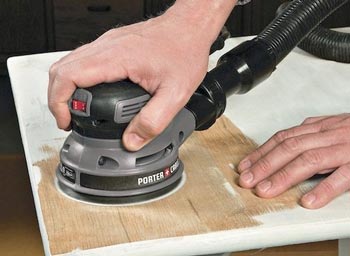
This is probably the most effortful method in the list, but it is also useful. With sandpaper and a sanding block, this can take a lot of time. If you use a sanding machine, then you can reduce the time and effort exponentially. Here’s what to do:
Things You’ll Need
•Sandpaper 150-grit and 80-grit
•Sanding block
•Sanding machine (optional)
•Water
•A piece of cloth or rag
As you see, you don’t need much for this method either.
Sand the Surface
There’s no time to waste, you can get on with the sanding right away.
1. Make sure to wear a protective mask and safety glasses before sanding.
2. Wrap the sandpaper around the sanding block.
3. Rub the sandpaper back and forth with even pressure.
4. If you want to sand a curved surface, you can use a dowel.
5. Brush the accumulated dust.
After you finish sanding, the wood should be very smooth to the touch.
Clean the Wood
Cleaning the wood will let it look neatly once again.
1. Rub a wet rag over the wood to wipe away any residue.
2. If it clogs, rotate the rag around or rewet it and continue wiping in the direction of the grain.
3. Keep wiping until the rag comes up clean. That’s the best way to tell if you’re done.
Once you’ve cleaned it up, then you’re ready to do any refurbishing if necessary.
Refinish the Wood
If you want to use the piece of wood for any purpose later, we recommend refinishing. This is how:
1. Once it’s dry, get a brush and touch up the wood using the same stain that was used before.
2. Wet the bristles about halfway up and then gently slap the brush on the side of the container.
3. Make sure to apply the finish in straight and even strokes moving in the direction of the grain.
4. Avoid over-brushing; as soon as the surface looks good, you should stop.
Refinishing the wood will help you give its color and smoothness back. You won’t have to work with a rough piece eventually.
6. Stripping Acrylic Paint Using a Solvent
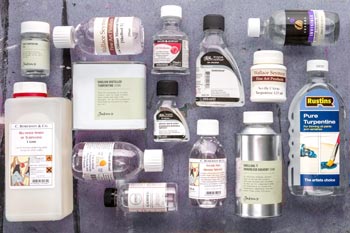
The most effective way to get rid of acrylic paint is to strip it away with a solvent. While this is the most effective method, it’s also the most dangerous.
Here’s how it works:
Choose a Solvent
This may not be an easy subject, but now that we are into chemicals, we have decided that it would best if we used methylene chloride. Keep in mind that this is an extremely potent chemical and should be used carefully.
Now, this chemical is based on citrus, so it is environmentally friendly. Yet, it is still a dangerous chemical, so don’t mess around with it. You can find it at most paint stores.
You may still find some alternatives like acrylic paint removers and things like that. But still, this is the best option you’ll find.
Gather the Items
•Solvent (as explained)
•Paintbrush or paint roller
•Putty knife
•Piece of cloth or rag
This should be enough to start getting rid of the paint with the solvent.
Follow Safety Measures
Following safety measures will help you stay damage-free when working with solvents. The fumes and other particles coming off the acrylic paint can be heavily damaging.
1. Wear long sleeves as the product could splash
2. Heavy gloves
3. Safety glasses
4. Goggles
5. A dust or ventilation mask
Once you’re done gearing up safety equipment, then you’re almost ready to start.
Ensure Proper Ventilation
But first, make sure to work in a decently ventilated area. Here’s a way to make that happen:
1. Allow air to move into and out of the house naturally.
2. Work outdoors if possible. If you can’t, open all the windows and doors.
3. You could also place a fan close so it blows the fumes away.
Don’t forget to be careful when trying to clean acrylic paint from your wood surface; take a few breaks in-between when doing so as it might be exhausting the first time around.
Spread the Solvent
You’ll need to spread the solvent on the wood surface, so it starts doing its effect. Here’s how:
1. Use the paintbrush or roller and make sure you have the right one for the job.
2. Pour the paint into the roller tray. Or just dip the paintbrush in the solvent.
3. Spread the solvent around the wood surface with the acrylic paint.
4. Then let it sit for 20 minutes or so. The paint should begin to bubble.
Be extra careful not to pour any of the solvents out of the wood surface. This solvent is highly toxic and usually damaging to animals, people, and even floors.
Scrape Off the Paint
After pouring the solvent and let it work, you’ll see how the paint starts to bubble out. Once this happens, you can start scraping it off.
1. Use a putty knife to scrape the paint bubbles off the wood.
2. Apply medium pressure as you rub back and forth.
3. Be careful when scraping off paint bubbles as you could damage the wood, and we don’t want that.
Make sure to get rid of every trace of acrylic paint.
Clean Up
Finish by cleaning the wood, so there’s no trace of acrylic paint, and at the same time, no solvent to worry about.
1. Pour water on a rag and start wiping until the wood is neutralized.
2. Don’t use it anywhere else. Once you’re done, throw it away.
If you get rid of all the acrylic paint and residues, then you’re almost done.
Let It Dry
Before you apply any stains or waxes, you should give your wood at least a week to dry completely.
Conclusion
Now that you’ve gotten this far, see how easy it is to get acrylic paint off wood? It does take a little bit of effort and time, but now your wood is clean and fresh.
You also learned how to remove paint from your wood, so now you could even remove your neighbor’s paint stain and make some money. At the end of the day, it’s a win-win.